.png)
ON THIS PAGE
Stay Updated with latest in AI SEO
20 August 2025
Published: July 01, 2025 | Reading Time: 15 minutes | Updated Monthly
Quick Answer: AI search optimization requires implementing structured data, creating LLMs.txt files, optimizing for conversational queries, and building entity-based content strategies. Early adopters see 30-40% visibility increases and 2.5x higher conversion rates from AI referral traffic.
AI search behavior has changed dramatically over the past 18 months, and what the data reveals will transform how you think about product discovery.
Remember when everyone said "mobile-first" was just a trend? AI search is happening now, and most DTC brands are completely unprepared.
Recent testing revealed a stark reality: stores with superior products and faster websites remain invisible while competitors with inferior offerings get featured in AI recommendations.
This represents a fundamental shift from optimizing for algorithms to optimizing for an entirely different way people discover and buy products.
Understanding what ChatGPT actually sees on websites reveals why traditional optimization approaches fall short.
.png)
AI platforms now handle over 15% of all search queries. That number was 3% just two years ago.
The key statistic: 58% of consumers already use AI tools for product recommendations. During last year's Black Friday, AI search referrals to retail sites jumped 1,300%.
These numbers represent either an opportunity or a threat, depending on your preparation level.
Traditional SEO optimizes for how Google's bots crawl your site. AI search optimizes for how artificial intelligence understands and recommends your products to real humans having real conversations.
The fundamental difference between AIO and traditional SEO resembles the difference between writing a technical manual and having a knowledgeable friend recommend something.
Months spent perfecting keyword strategies often result in AI systems completely ignoring "perfectly optimized" product pages because they lack conversational context and structured data.
Everyone discusses robots.txt, but few mention LLMs.txt. This file tells AI systems which of your pages matter most.
Think of it as your AI-friendly sitemap. While robots.txt says "don't go here," LLMs.txt says "this is the good stuff."
.png)
Step 1: Create a simple markdown file at yoursite.com/llms.txt (in your root directory, same level as robots.txt)
Step 2: List your 10-15 most important pages with clear descriptions
Step 3: Add a brief brand summary in blockquote format
Example structure:
> Sustainable streetwear brand focused on eco-friendly materials and ethical manufacturing. We create everyday essentials that don't compromise on style or environmental responsibility.
## Essential Pages
- [Men's Collection](https://example.com/mens) - Sustainable streetwear for the modern guy
- [Size Guide](https://example.com/sizing) - Find your perfect fit
- [Our Impact](https://example.com/sustainability) - How we're changing fashion
Most brands still don't have this file, creating immediate competitive advantage for early implementers.
Your robots.txt file (also in your root directory at yoursite.com/robots.txt) needs explicit AI crawler permissions.
.png)
# Allow AI crawlers
User-agent: GPTBot
Allow: /
User-agent: ClaudeBot
Allow: /
User-agent: ChatGPT-User
Allow: /
User-agent: AppleBot
Allow: /
# Block sensitive areas from everyone
User-agent: *
Disallow: /admin/
Disallow: /checkout/
Disallow: /cart/
Disallow: /account/Most sites accidentally block AI crawlers because they're not specifically allowed. This single oversight eliminates AI visibility entirely.
Schema markup implementation reveals a critical technical limitation: ChatGPT and Claude can't read JavaScript-injected content. Only Google's Gemini can handle that.
This means if your product information loads via JavaScript (common in Shopify themes), AI systems might not see your most important details.
The solution: Ensure core product information (name, price, description, availability) appears in the initial HTML. Save fancy interactions for after page load.
For Shopify stores specifically, our complete LLM readiness checklist covers the 7 most common issues brands miss.
Traffic from AI sources increased 40% within one month after implementing proper Product schema across an entire catalog.
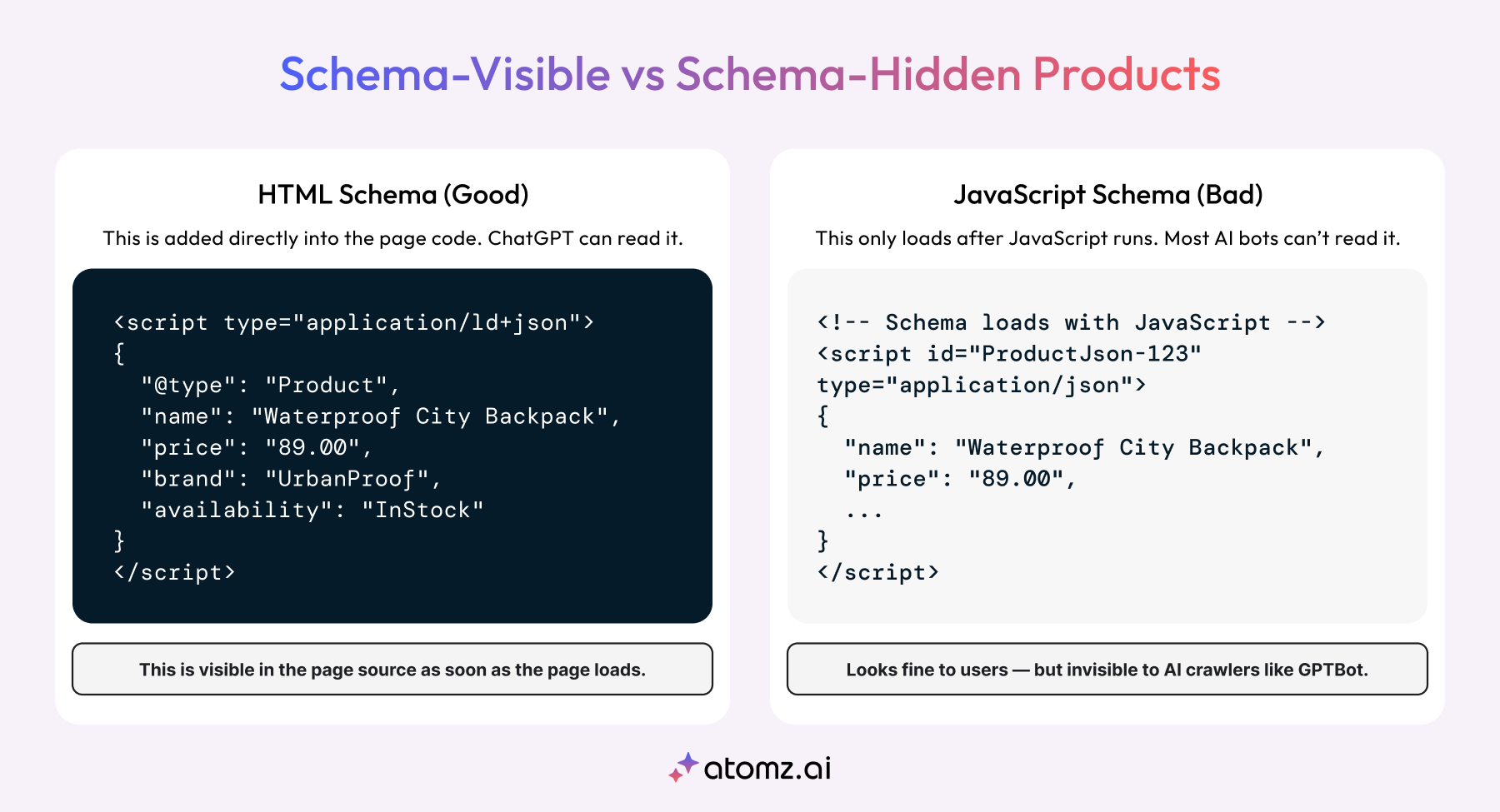
ChatGPT prefers comprehensive resources over elevator pitches. Long-form content (2,000+ words) gets cited significantly more often than concise product descriptions.
What works: Detailed buyer's guides, comparison articles, extensive FAQsWhat doesn't: Brief product specs, marketing fluff
Check out our guide on prompt writing techniques that make AI systems want to recommend your products.
Perplexity is growing 40% month-over-month and prioritizes credible sources.
Securing mentions in industry publications leads to consistent Perplexity citations. One trade magazine article can boost AI visibility for six months.
Pro tip: Develop relationships with industry journalists. One good quote can transform your AI visibility.
Our analysis of how LLMs rank, recall, and cite pages breaks down the complete process.
Gemini remains the most Google-like AI platform, prioritizing Experience, Expertise, Authoritativeness, and Trustworthiness.
Optimization strategies:
Proper schema, FAQs, and technical SEO can make or break your AI visibility.
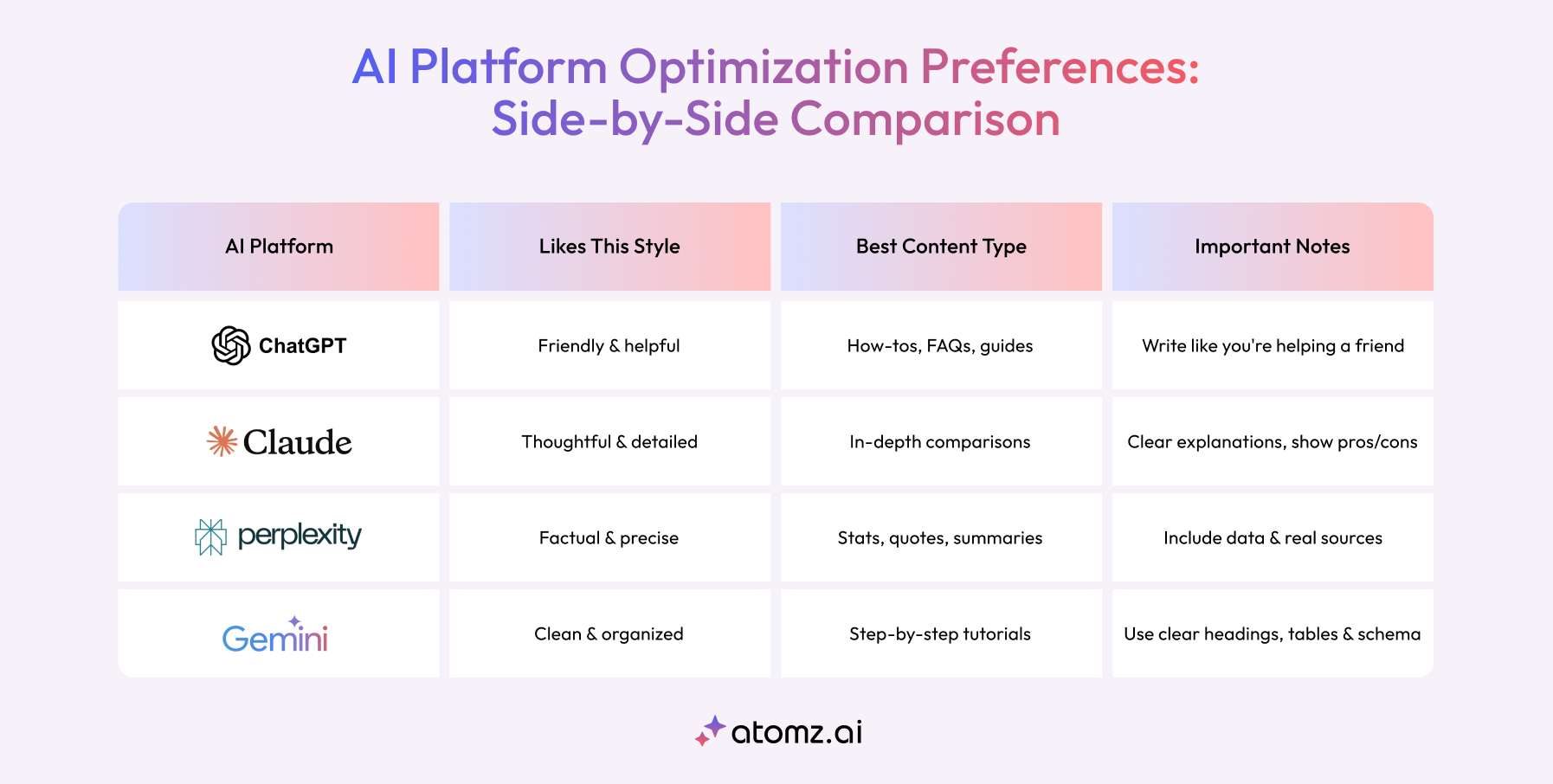
Analysis of hundreds of AI responses reveals clear patterns in quoted content:
Step-by-step guides with specific outcomesExample: "How to Choose Running Shoes for Flat Feet: A Podiatrist's Guide"
Side-by-side analysis with clear winnersExample: "Memory Foam vs. Latex Pillows: 6 Factors That Actually Matter"
Clear problems with actionable solutionsExample: "Why Your Skincare Routine Isn't Working (And 3 Simple Fixes)"
These formats sound like real conversations, which is intentional.
The shift toward prompt-led discovery means customers are literally having conversations with AI about your products. Your content needs to sound natural in that context.
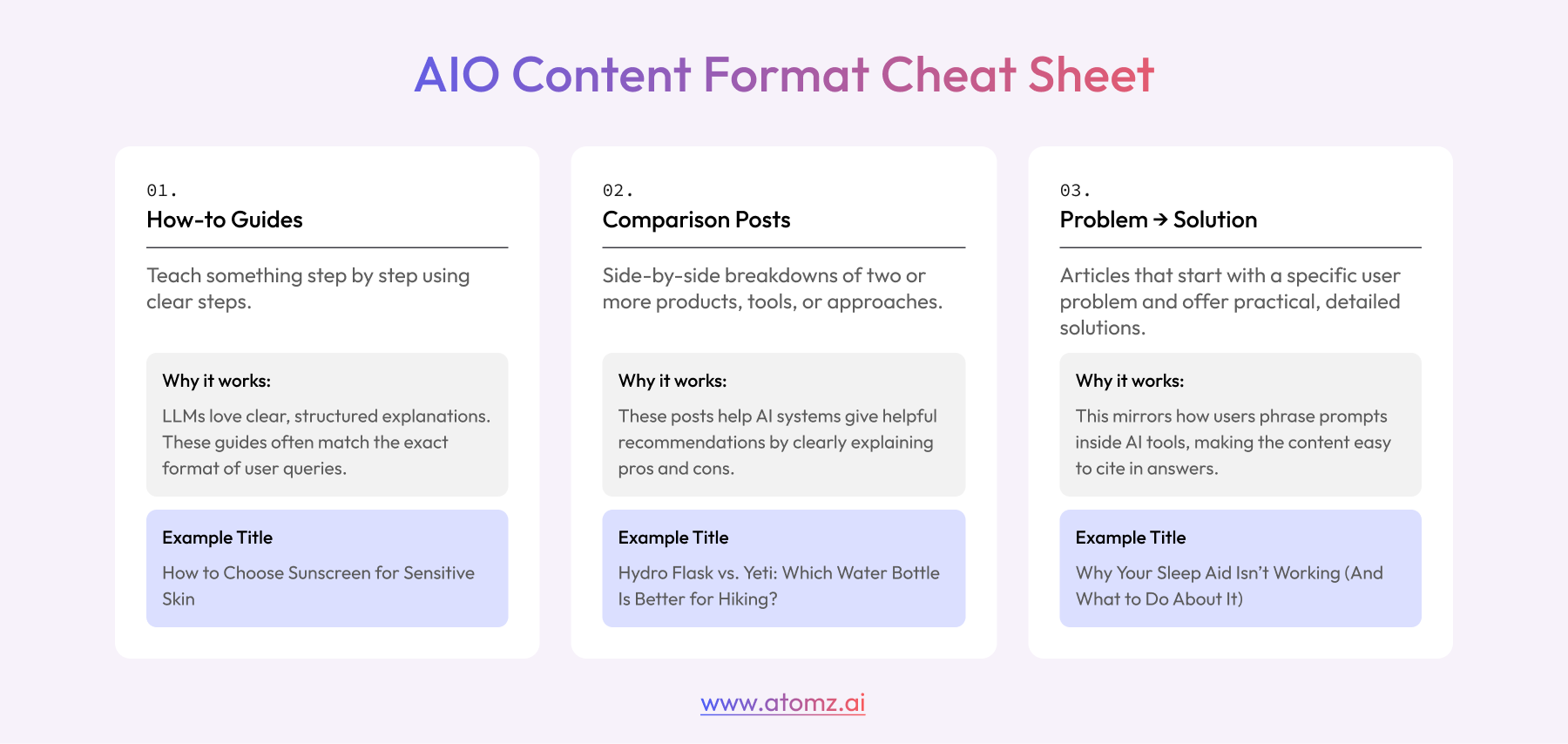
Traditional metrics don't capture AI search performance. New KPIs include:
Citation Rate: How often you're mentioned in AI responses to relevant queries
Brand Sentiment: What AI systems say about your brand (positive, neutral, negative)
Context Accuracy: Whether AI understands what you actually sell
Monthly tracking uses a combination of manual searches and tools like Profound (for citation tracking) and brand monitoring services.
Reality check: Results take time. Meaningful improvements typically require 3 months. But when optimization works, the compound effect becomes incredible.
The complete journey, including what worked, what failed, and exact timelines, is documented in our 30-day AI SEO experiment.
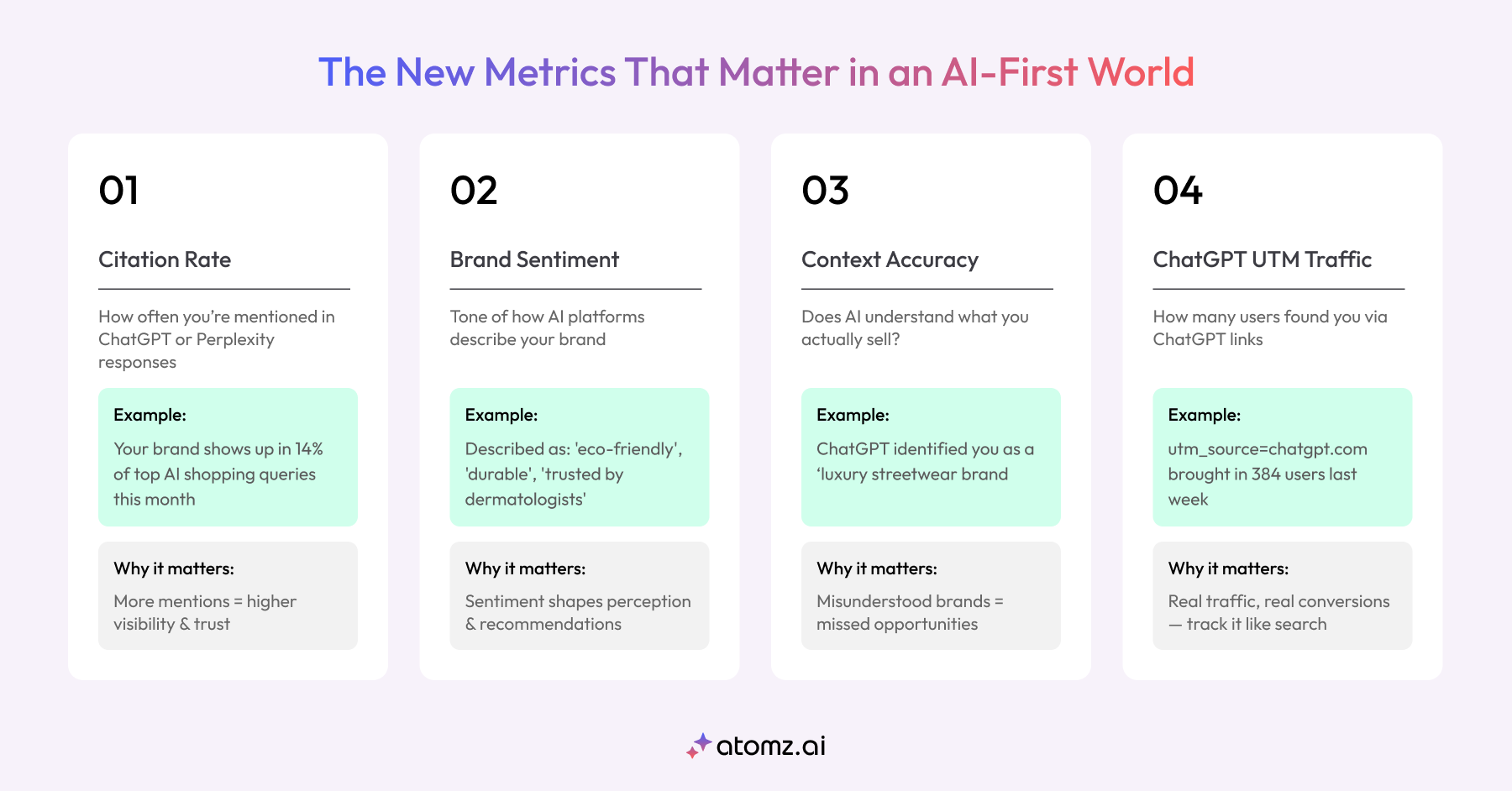
Based on successful optimization patterns across multiple brands:
Throughout this process, understanding why internal links matter more in AI overviews helps structure content for maximum impact.
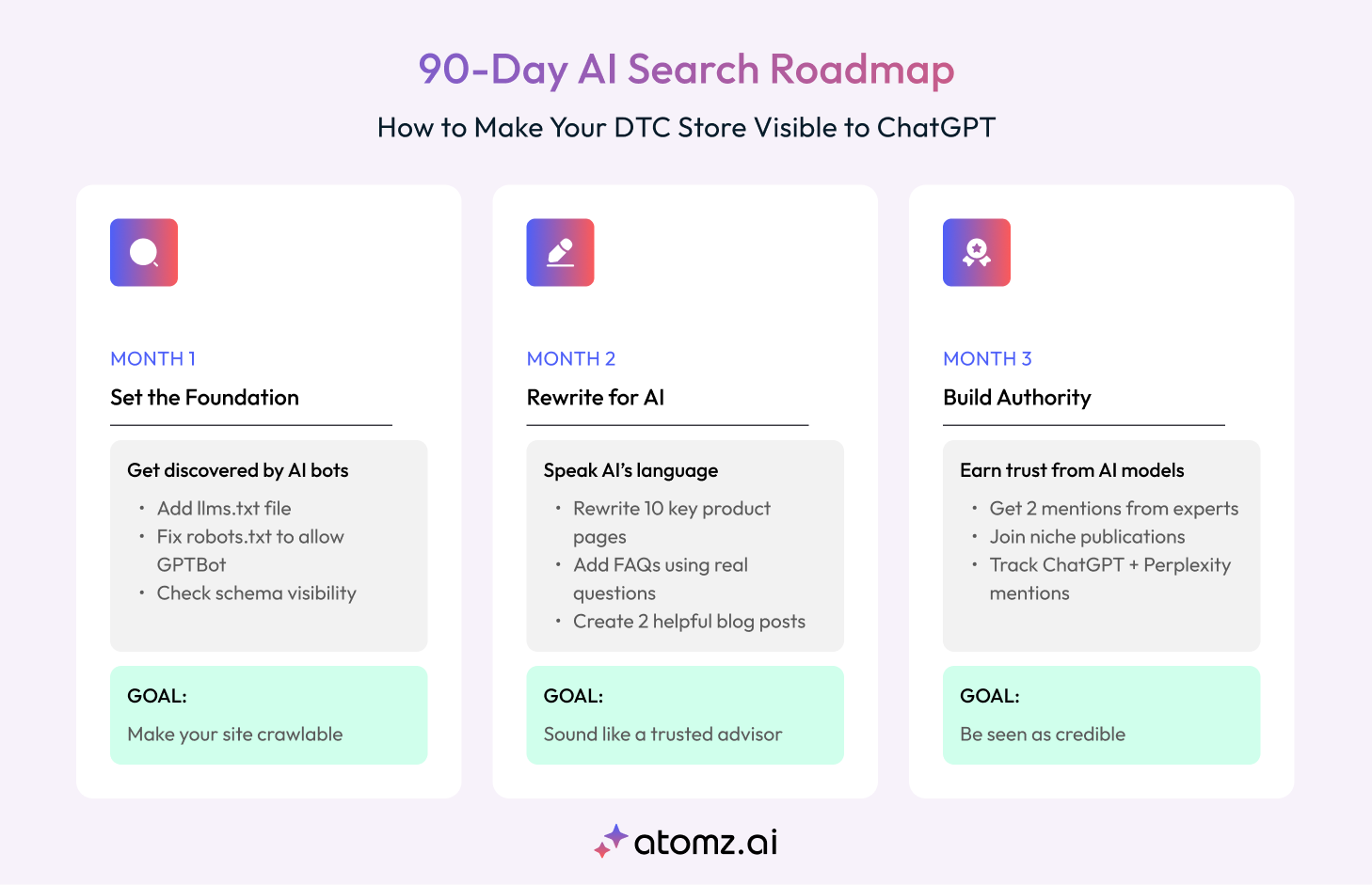
AI doesn't care about keyword density. It cares about context and usefulness. This fundamental shift explains why LLMs don't crawl but summarize, which changes everything about optimization approach.
ChatGPT, Perplexity, and Claude each have different preferences. Optimize for all platforms. Our guide on optimizing your site for Perplexity covers platform-specific strategies.
AI platforms take time to understand and trust your content. Plan for 3-6 months.
Write like you're talking to a friend, not writing a technical manual. Learn how to write FAQs that get cited by GPT-4 for practical examples.
Most DTC brands will be too slow to adapt to AI search optimization.
While brands debate whether AI search matters, competitors are implementing these strategies. The brands that move now will dominate AI recommendations for years.
This pattern appeared with mobile optimization, social commerce, and influencer marketing. Early movers win big. Late adopters struggle to catch up.
For deeper understanding, start with learning how to audit your brand's AI presence using specialized tools.
Don't overcomplicate the process. Pick one thing and execute it well:
The opportunity is massive, but the window won't stay open forever. AI search is moving from "nice to have" to "essential for survival."
Your competitors are probably reading similar advice.
The question becomes: who will implement it first?
-
Want to see how AI currently sees your brand?
Run our free AI visibility analysis and get a personalized action plan for your store.
Streamline your workflow, achieve more
Richard Thomas
Create buying intent instantly
Create buying intent before customers search. 25%+ conversion lift guaranteed.
Why Prompts Matter
AI Search That Converts 3x Better
Get the latest in AI-powered search, UX trends, and eCommerce conversions—straight to your inbo
No spam. Just powerful insights.
👉 Join thousands of growth-focused brands.

